Contents
Introduction
What Is NGOSS?
• eTOM Business Process Map: An industry-agreed set of integrated business process descriptions, created with today's customer-centric market in mind, used for mapping and analyzing operational processes.
• Shared Information/Data (SID) Model: Comprehensive, standardized information definitions acting as the common language for all data to be used in NGOSS-based applications. A common information language is the linchpin in creating easy-to-integrate software solutions.
• Technology Neutral Architecture: Key architectural guidelines and specifications to ensure high levels of flow-through amongst diverse systems and components.
• Compliance and Conformance Criteria: Guidelines and tests to ensure that systems defined and developed utilizing NGOSS specifications will interoperate.
• Lifecycle and Methodology: Processes and artifacts that allow developers and integrators to use the toolset to develop NGOSS-based solutions employing a standard approach.
Figure 1. NGOSS Structure (Copyright TM Forum)
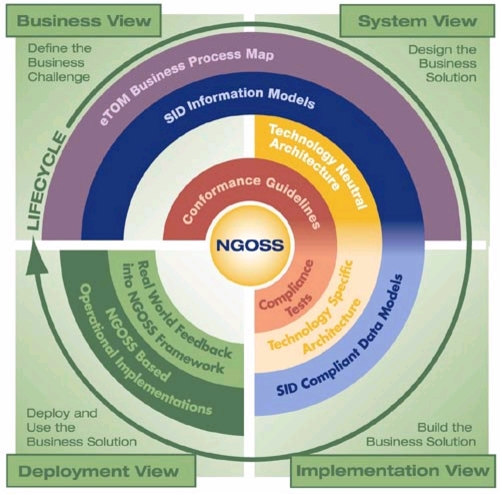
• For service providers
– Facilitate the implementation of cost-effective OSS/BSS solutions through standard specifications and interfaces
– Provide long-term direction for IT strategy by specifying a business process framework
– Enable IT systems to support rapidly evolving integrated service offerings by offering a logical system view independent of the particular service or software provider
– Reduce operational costs through tighter coupling of business processes and more automation
• For OSS software vendors
– Reduce development costs by using a standard framework specification
– Simplify interoperability with other components based on a standard set of interfaces and use cases
• For systems integrators
– Facilitate predictable, repeatable, and scalable implementation projects by using standard components
– Enable a broader, multivendor portfolio without a steep learning curve through the use of a common set of specifications
• Business process redesign: Service providers utilize the eTOM to analyze their existing business processes, identify redundancy or gaps in their current strategies, and re-engineer processes to correct deficiencies and add automation.
• Designing and specifying OSS/BSS solutions: NGOSS defines detailed information models, interface, and architectural specifications that service providers can utilize to stipulate and procure future solutions.
• Software application development: The NGOSS components, the eTOM, the SID, the Technology Neutral Architecture, the Methodology and Lifecycle Guidelines, and the NGOSS solutions suites are designed to walk software engineering organizations through the process of creating NGOSS-compliant OSS/BSS components.
• Systems integration: When faced with integration challenges, NGOSS's well-defined business and system language, interfaces, and architecture provide the system integrator with a clear direction for repeatable and cost-effective integration of multivendor, disparate systems.
History and Context of eTOM
Figure 2. TMN FCAPS Structure
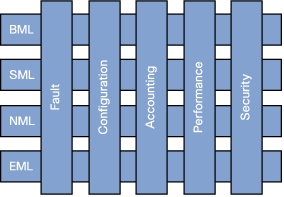
What Is eTOM?
• Strategy, Infrastructure, and Product (SIP) covering planning and lifecycle management
• Operations covering the core of day-to-day operational management
• Enterprise Management covering corporate or business support management
Figure 3. eTOM Level 0 Model (Copyright TM Forum)
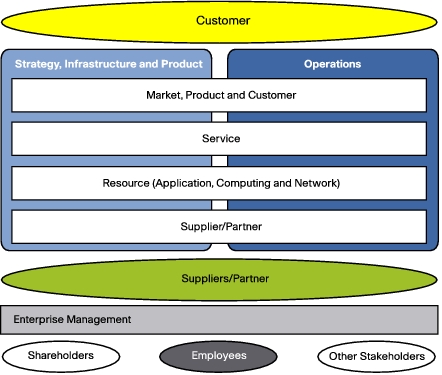
• Market, Product, and Customer: High-level view of the market and the enterprise's offerings
• Service: Product components developed by the enterprise
• Resource (Application, Computing, and Network): Consumed in the production of the Service
• Supplier/Partner: Providing products and services to the enterprise for the production of the Service
Figure 4. eTOM Level 1 Model (Copyright TM Forum)
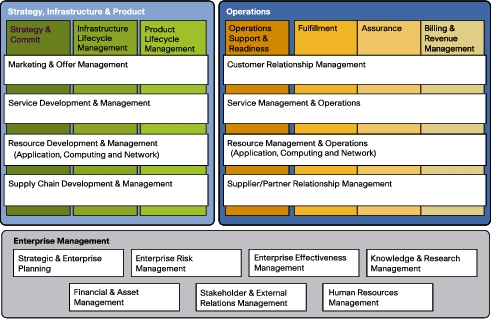
Figure 5. Operations Level 2 Processes (Copyright TM Forum)
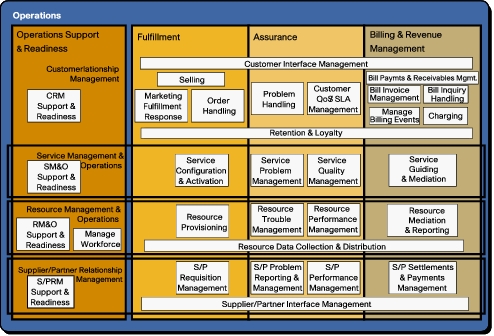
Figure 6. SIP Level 2 Processes (Copyright TM Forum)
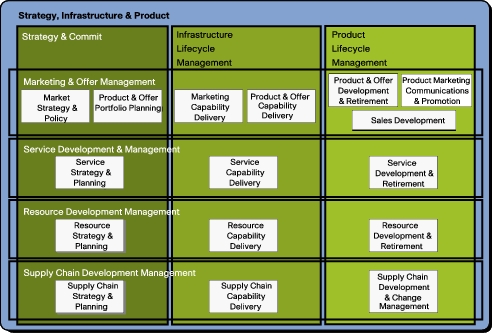
Figure 7. Enterprise Management Level 2 Processes (Copyright TM Forum)
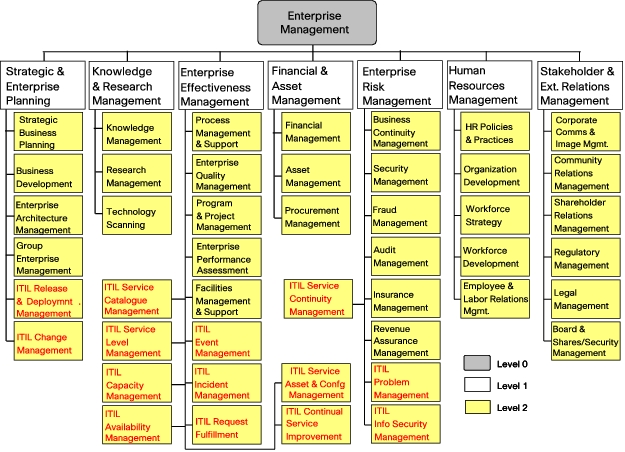
• Level 0: Business Activities that distinguish operational customer-oriented processes from management and strategic processes
• Level 1: Process Groupings including business functions and standard end-to-end processes
• Level 2: Core Processes that combine together to deliver service streams and other end-to-end processes
• Level 3: Tasks and associated detailed "success model" business process flows
• Level 4: Steps and associated detailed operational process flows with error conditions and product and geographical variants (where required)
• Level 5: Further decomposition into operations and associated operational process flows where required
Using eTOM
• It makes available a standard structure, terminology, and classification scheme for describing business processes and their constituent building blocks
• It supplies a foundation for applying enterprise-wide discipline to the development of business processes
• It provides a basis for understanding and managing portfolios of IT applications in terms of business process requirements
• It enables the creation of consistent and high-quality end-to-end process flows, with opportunities for cost and performance improvement, and for re-use of existing processes and systems
• Its use across the industry will increase the likelihood that off-the-shelf applications will be readily integrated into the enterprise, at a lower cost than custom-built applications
Figure 8. Process Interaction Example
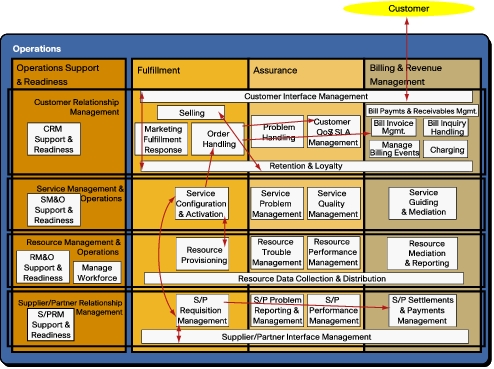
Figure 9. Process Flow Example (Copyright TM Forum)
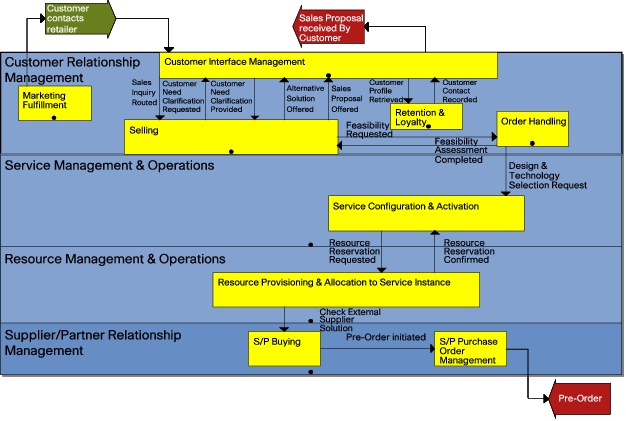
eTOM and ITIL®
Table 1. eTOM-ITIL Similarities and Differences
|
eTOM |
ITIL® |
|
|
Context |
• eTOM is a prescriptive catalogue of Process Element categories and a total enterprise process framework for the ICT industry.
|
• ITIL® is a set of nonprescriptive guidelines for IT/ICT Service Management.
|
|
Objectives |
• Provides a business process blueprint for service providers to streamline their end-to-end processes.
• Enables effective communication and common vocabularies within the enterprise as well as with customers and suppliers.
|
• Aligns IT services with the current and future needs of the business and its customers.
• Enables standard terminology across business and IT.
• Improves the quality of the IT services delivered.
• Reduces the long-term cost of service provision.
|
|
Scope |
• Provides a top-down hierarchical view of business processes across the whole enterprise and does not itself address how these processes are supported by automated or human action (this is, however, addressed in the wider NGOSS program of the TMF).
• Processes are developed through iterative decomposition.
• It focuses on identifying the commonality of enterprise processes required among similar services, such as telephony, data, Internet, mobiles, etc., for delivering high-quality, end-to-end service management.
• eTOM focuses on service delivery to external customers.
|
• The ITIL® processes represent flows in a number of key operational areas, with a strong orientation towards how these processes will map onto IT support environments.
• Processes are developed through flows.
• It is primarily nonprescriptive, offers advice and guidance on the implementation and continued delivery of service management, including planning common processes, roles, and activities with appropriate reference to each other and how the communication lines should exist between them.
• ITIL® is primarily focusing on serving internal IT customers.
|
|
Adoption |
• eTOM has been adopted as ITU International Standards for the Telecom Sector, and primarily used by Service Providers in the ICT industry. eTOM is advanced by TM Forum: http://www.tmforum.org/
|
• ITIL® is a set of best practices that is used by tens of thousands of companies worldwide and continues to be advanced by itSMF local chapters: http://www.itsmf.com/
|
|
Implementation |
• eTOM is a framework; therefore, the implementation will be different from company to company.
• The implementation of eTOM is supported by other TMF/NGOSS specifications, including the Shared Information/Data Model (SID), NGOSS Lifecycle and Methodology, and other related specifications.
|
• ITIL® is a framework; therefore, the implementation will be different from company to company.
• Until recently, ITIL® did not provide guidelines on the implementation order or means to assess the maturity of the service organization. In Version 3, more attention is being paid to implementation guidelines.
|
|
Compliance |
• eTOM compliance is achieved through the TMF/NGOSS Compliance Program; its certification is on tools not on organizations or processes. NGOSS compliance program encompass the conformance tests of other NGOSS specifications that further define the business objects and operations framework required for effective eTOM implementation.
|
• ITIL® is not a standard, nor is it a set of regulations, and, therefore, neither tools, processes, or people can be deemed "ITIL® compliant." Processes and organizations can be assessed against ISO 20000, the IT Service Management standard based on ITIL®. However, neither tools nor individuals can be certified against ISO 20000.
|
Figure 10. Converging eTOM and ITIL®
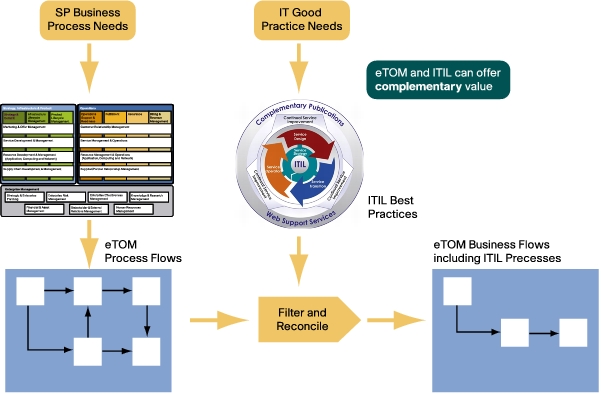
References
• TM Forum: www.tmforum.org
– The whole NGOSS documentation (including eTOM)
– White papers
– Collaboration groups
– Courses and certification exams
• ITIL®
– Official ITIL® site: www.itil.co.uk
– itSMF International: www.itsmf.com
• ITU-T